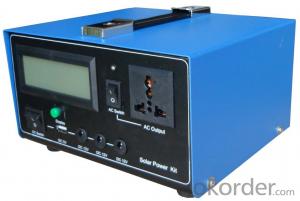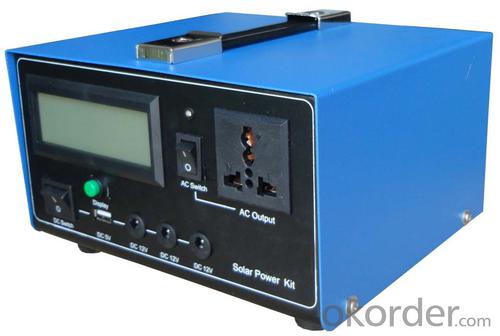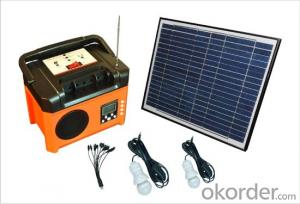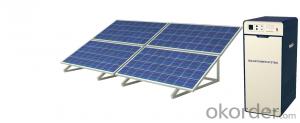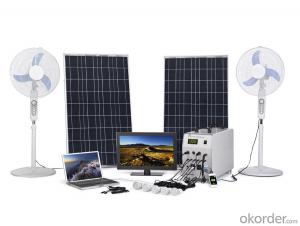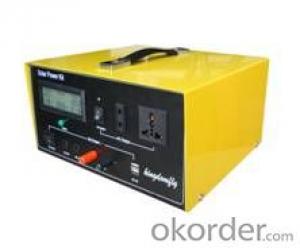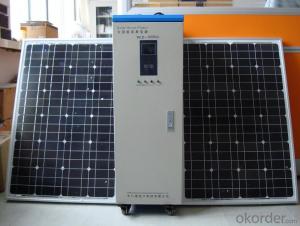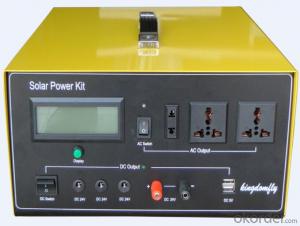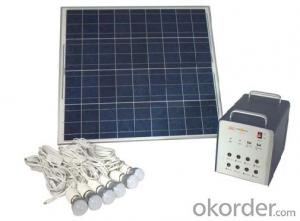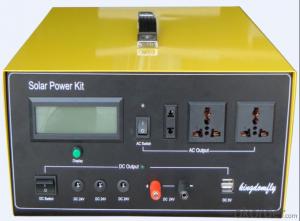Solar Energy Systems for Homes - SPK-300 LCD Solar Power System
- Loading Port:
- China main port
- Payment Terms:
- TT or LC
- Min Order Qty:
- 10 pc
- Supply Capability:
- 10000 pc/month
OKorder Service Pledge
OKorder Financial Service
You Might Also Like
A solar inverter, or PV inverter, or Solar converter, converts the variable direct current (DC) output of a photovoltaic (PV) solar panel into a utility frequency alternating current (AC) that can be fed into a commercial electrical grid or used by a local, off-grid electrical network.
It is a critical BOS–component in a photovoltaic system, allowing the use of ordinary AC-powered equipment.
Solar inverters have special functions adapted for use with photovoltaic arrays, including maximum power point tracking and anti-islanding protection.
Main Information
KDF SPK_300_LCD
This product is high performance, family used portable solar power system, which can receive energy and store it in battery outside connected to SPK by solar energy on sunny day, and supplies electric power for varies appliances such as electric fan, lighting lamps, television, portable computer etc.
It can supply power for both DC and AC electric application.
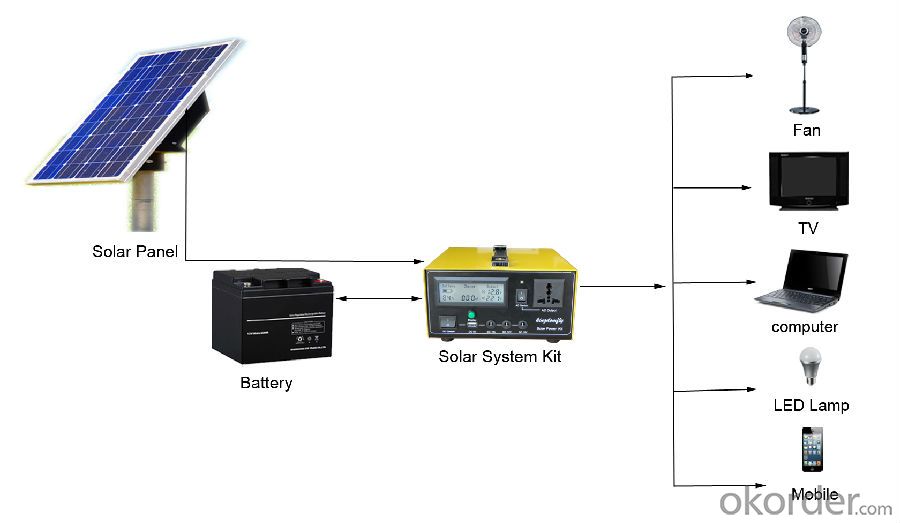
Main features:
◆ Battery puts outside connected to the SPK for user to choose battery in recommended range, and easily to exchange battery.
◆ Both DC and AC output
◆ Solar Feedback Circuit Protection
◆ Output Short-circuit Protection
◆ Solar「+」「-」anti-access protection
◆ Output「+」「-」anti-access protection
◆ Over Charged Protection
◆ Over Discharged Protection
◆ Over Load Protection
◆ Over-Temperature Protection
Technical parameters
Specification | Value/Material | |
Item No. KDF | SPK_300_LCD | |
Solar Recommended | Specification | Poly silicon |
Working Voltage/Power | 18V80W~120W | |
Battery Recommended | Rated Voltage/Capacity | 12V65AH~100AH |
Cycle Number | 80% Deep Cycle Number:500 70% Cycle Number:800 | |
Working Temperature | Short Period(one Month):-20~50℃ Long Period(Six Months):-10~45℃ | |
Charging Controller | Operating Voltage | 12V |
Input Voltage | 17.3V~21V | |
Input current | MAX:10A | |
Power Consumption | MAX: 5mA | |
Low Voltage Disconnect(LVD) | 10.8V | |
Low Voltage Reconnect(LVR) | 12.3V | |
High Voltage Discharge( HVC) | 14.6V | |
High Voltage Recharge(HVR) | 13.8V | |
Temperature Protection | 60℃ | |
DC Output | DC output & Application | USB 5V2A |
DC output & Application | DC 12V1*3A | |
AC Output | Output Wave | modified sine wave |
Input Voltage | 11V~15V | |
Output Voltage | 110V±10% | |
Output Frequency | 60Hz±2Hz/50Hz±2Hz | |
Rated Output Power | 300W | |
Maximum VA | 600VA | |
Maximum Efficiency | 88% | |
Temperature | 0-40℃ | |
Over Temperature | 60℃~70℃ | |
Low Voltage Alarm | 11V | |
Low Voltage Shut off | 10.5V | |
High Voltage Shut off | 16V | |
Package | Set size | 278*240*172mm |
Set N·W | 2.8kg | |
Set N·W | 3.6kg | |


No. | Name | Function |
1 | Battery Icon | To show the Volume of the Battery |
2 | Date of % | To show the percent of the Battery |
3 | Charging Icon | To show the charging condition |
4 | Current | To show the value of charge current |
5 | Temperature Icon | Temperature Alarm |
6 | Date of Voltage | To Show the Value of DC output voltage |
7 | Date of Voltage | To Show the Value of AC output voltage |
8 | AC Icon | AC output |
9 | DC Icon | DC output |
This product can be used for any type of solar home systems. It has high conversion efficiency, reliable quality, intelligent monitoring system and best service, which will provide you with a memorable user experience and solutions.
- Q: Can solar energy systems be used in areas with limited access to solar energy advocacy groups?
- Yes, solar energy systems can still be used in areas with limited access to solar energy advocacy groups. While the presence of advocacy groups can provide additional resources and support, the feasibility of installing and utilizing solar energy systems depends primarily on the availability and intensity of sunlight in the given area. If the region receives sufficient sunlight, individuals or communities can still adopt solar energy independently, even without the presence of advocacy groups. The use of solar energy systems can help reduce reliance on traditional energy sources, lower electricity costs, and contribute to a more sustainable future.
- Q: How much space is needed to install a solar energy system?
- The amount of space required for installing a solar energy system varies based on several factors such as the capacity of the system, the type of solar panels used, and the available sunlight. On average, for residential installations, a solar energy system typically requires around 100-400 square feet of roof space per kilowatt (kW) of solar capacity. However, ground-mounted systems can require more space, especially for larger installations. It is essential to conduct a site evaluation to determine the specific space requirements for a solar energy system.
- Q: How do solar energy systems contribute to reducing the need for new power plant construction?
- Solar energy systems contribute to reducing the need for new power plant construction by generating electricity directly from the sun, eliminating the need for additional power plants. This renewable energy source helps meet the growing energy demand while minimizing the environmental impact and reducing reliance on fossil fuels.
- Q: Can solar energy systems be financed or leased?
- Yes, solar energy systems can be financed or leased. Many companies and financial institutions offer financing options to make solar energy systems more affordable for homeowners and businesses. Leasing is another popular option where the solar panels are owned and maintained by a third-party company, allowing customers to benefit from the energy generated without the upfront costs of purchasing the system.
- Q: Are there any noise or vibration issues with solar energy systems?
- Yes, there can be noise and vibration issues with solar energy systems, although they are generally minimal compared to other forms of energy generation. Solar panels themselves do not produce any noise or vibration as they convert sunlight into electricity. However, some components of the system, such as inverters or mounting structures, may generate a slight humming sound or vibration. This can vary depending on the quality and design of the system. Additionally, if the solar panels are installed on a roof or near living spaces, there might be some audible noise or vibration transmission through the building structure. However, these issues are typically considered minor and are often outweighed by the environmental and economic benefits of solar energy.
- Q: How do solar energy systems impact the health and well-being of communities?
- Solar energy systems have a significant positive impact on the health and well-being of communities. One of the most significant benefits is the reduction in air pollution. Traditional energy sources such as coal and natural gas emit harmful pollutants that can cause respiratory problems, cardiovascular diseases, and even cancer. Solar energy systems produce clean and renewable energy, resulting in reduced air pollution and improved air quality. By reducing reliance on fossil fuels, solar energy systems also contribute to mitigating climate change. Climate change has numerous adverse health effects, including increased heat-related illnesses, the spread of infectious diseases, and food and water scarcity. Solar energy helps in reducing greenhouse gas emissions, which in turn helps to combat climate change and protect the health of communities. Moreover, solar energy systems have positive economic impacts on communities. They create job opportunities in the installation, maintenance, and manufacturing sectors. These jobs not only provide income but also contribute to the well-being of individuals and families. Additionally, solar energy systems can reduce electricity costs for households, freeing up financial resources that can be utilized for other essential needs, such as healthcare and education. Solar energy systems also enhance the resilience and reliability of energy supply in communities. They are decentralized and can be installed on rooftops or in smaller-scale installations, reducing the vulnerability of communities to power outages caused by natural disasters or infrastructure failures. This reliability ensures that critical services such as hospitals, schools, and emergency response centers can continue to function during power disruptions, ultimately protecting the health and safety of community members. Furthermore, solar energy systems promote energy independence and energy equity. Communities that have limited access to reliable electricity can benefit from solar energy systems, which can be installed in remote or underserved areas. This improves the quality of life for individuals in these communities by providing them with access to clean and affordable energy. In conclusion, solar energy systems have a profound impact on the health and well-being of communities. By reducing air pollution, mitigating climate change, creating jobs, enhancing energy resilience, and promoting energy equity, solar energy systems contribute to healthier and more sustainable communities.
- Q: Can solar panels be installed on agricultural land without affecting crop production?
- Yes, solar panels can be installed on agricultural land without significantly affecting crop production. By utilizing innovative designs such as elevated solar arrays or agrivoltaic systems, which combine solar energy production and crop cultivation, farmers can capitalize on the dual benefits of generating clean energy while maintaining crop yields. These systems are designed to optimize land usage, minimize shading, and provide a suitable environment for crops to thrive. Proper planning, consideration of crop types, and effective management practices can ensure that solar panels and agriculture can coexist harmoniously, benefiting both energy production and crop productivity.
- Q: Can solar energy systems be used in residential apartments or multi-story buildings?
- Yes, solar energy systems can certainly be used in residential apartments or multi-story buildings. In fact, they are increasingly being integrated into such settings as a viable and sustainable energy solution. Solar panels can be installed on the rooftops of these buildings to harness the sun's energy and convert it into electricity. This electricity can then be used to power various appliances, lighting, and other electrical devices within the apartments or building. Additionally, solar energy systems can also be designed to store excess energy for later use or even feed it back into the grid, allowing residents to benefit from net metering. While the feasibility of installing solar panels in these settings may vary depending on factors like available roof space and building orientation, advances in technology have made it easier and more affordable to implement solar energy systems in residential apartments and multi-story buildings.
- Q: Are there any government grants or funding options for solar energy systems?
- Yes, there are government grants and funding options available for solar energy systems. Various government agencies and programs offer financial incentives, such as grants, loans, tax credits, and rebates, to encourage the adoption and installation of solar energy systems. These incentives aim to promote renewable energy, reduce reliance on fossil fuels, and support the growth of the solar industry. It is recommended to research and consult with local government entities, utility companies, and relevant federal programs to explore the specific grants and funding options available in a particular region.
- Q: Are there any tax benefits for installing a solar energy system?
- Yes, there are tax benefits available for installing a solar energy system. The federal government offers a Solar Investment Tax Credit (ITC), allowing homeowners and businesses to deduct a percentage of the system's cost from their taxes. Additionally, some states provide additional incentives such as tax credits, exemptions, or grants to promote the adoption of solar energy. It is advisable to consult a tax professional or visit the government's official websites for the most accurate and up-to-date information on available tax benefits.
Send your message to us
Solar Energy Systems for Homes - SPK-300 LCD Solar Power System
- Loading Port:
- China main port
- Payment Terms:
- TT or LC
- Min Order Qty:
- 10 pc
- Supply Capability:
- 10000 pc/month
OKorder Service Pledge
OKorder Financial Service
Similar products
Hot products
Hot Searches
Related keywords
